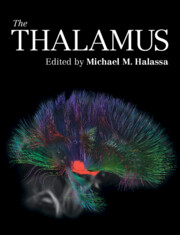Book contents
- The Thalamus
- The Thalamus
- Copyright page
- Contents
- Contributors
- Preface
- Section 1: History
- Section 2: Anatomy
- Section 3: Evolution
- Section 4: Development
- Section 5: Sensory Processing
- Section 6: Motor Control
- Section 7: Cognition
- Section 8: Arousal
- Chapter 19 The Thalamus and Sleep
- Chapter 20 Central Thalamic Contributions to Arousal Regulation
- Section 9: Computation
- Index
- References
Chapter 20 - Central Thalamic Contributions to Arousal Regulation
from Section 8: - Arousal
Published online by Cambridge University Press: 12 August 2022
- The Thalamus
- The Thalamus
- Copyright page
- Contents
- Contributors
- Preface
- Section 1: History
- Section 2: Anatomy
- Section 3: Evolution
- Section 4: Development
- Section 5: Sensory Processing
- Section 6: Motor Control
- Section 7: Cognition
- Section 8: Arousal
- Chapter 19 The Thalamus and Sleep
- Chapter 20 Central Thalamic Contributions to Arousal Regulation
- Section 9: Computation
- Index
- References
Summary
This chapter traces the scientific and clinical evidence supporting the key role of the central thalamus in forebrain arousal-regulation mechanisms. Beginning from the original studies of Moruzzi and Magoun in the late 1940s, the evolving concepts of defined pathways extending from the central regions of the thalamus that modulate arousal via their projections to cortical and striatal neuronal populations are carefully examined.Anatomical and physiological distinctions between the main subnuclei grouped within the often loosely defined "central thalamus," the more rostral central lateral and paracentral nuclei (CL/Pc), and the more caudal centromedian-parafasicularis complex (Cm-Pf) are reviewed across experimental studies in rodents, cats, and non-human primates. In addition, relevant human neuroimaging, neurophysiological, lesion correlation, and interventional neurosurgical studies are compared and discussed in the context of the reviewed basic neuroscience studies characterizing the central thalamus. Several scientific controversies surrounding the contributions of the central thalamus to forebrain arousal are specifically considered. This synoptic review is further used to unpack the rationale for the use of electrical stimulation centered on the CL/Pc populations to support impaired arousal regulation resulting from relatively deafferented frontal cortical and striatal populations in patients across a wide range of outcomes following coma induced by structural brain injuries.
Keywords
- Type
- Chapter
- Information
- The Thalamus , pp. 382 - 400Publisher: Cambridge University PressPrint publication year: 2022

